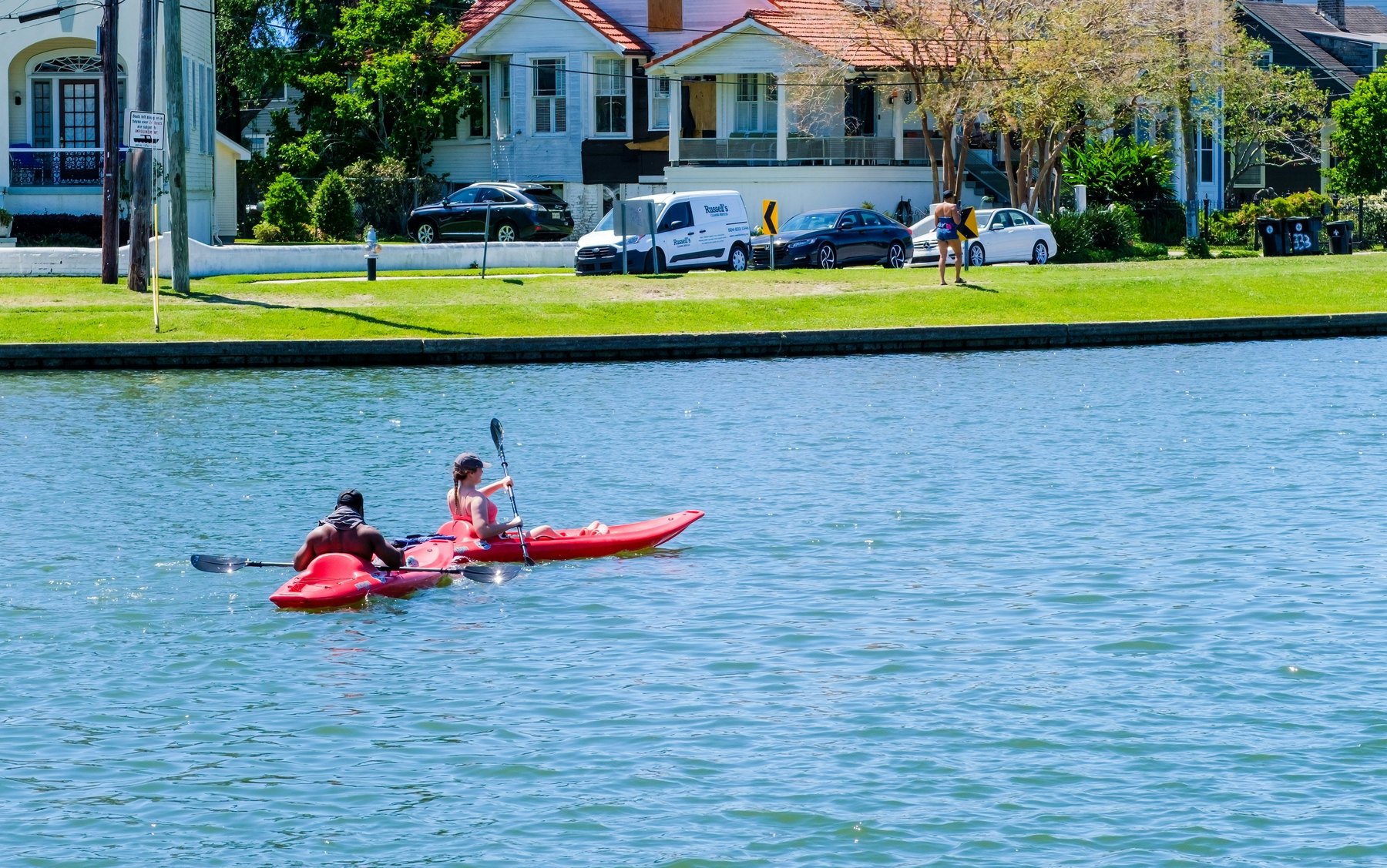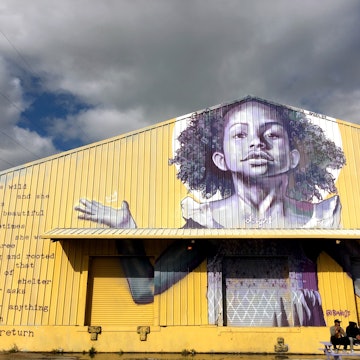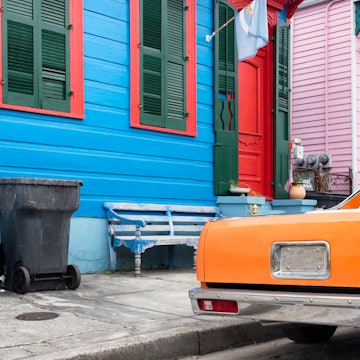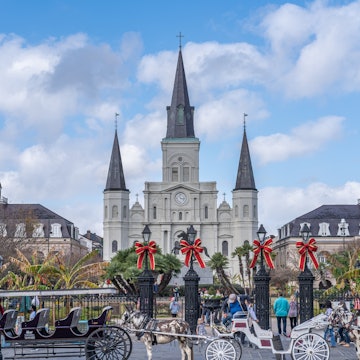

Find your way to the best neighborhoods in New Orleans with this guide © Jupiterimages / Getty Images
There is nowhere in the US quite like New Orleans.
This unique city sits at a sort of space-time intersection that mixes up elements of Europe, Africa, the Caribbean, and of course, North America. Each neighborhood offers something special.
You can dine on Vietnamese food married to Southern grits in the shadow of a giant Latin American grocery store for dinner, find your soul at a jazz show that feels like it slipped out of the early 20th century for dessert, and have a nightcap of punk rock next to a mural steeped in the contemporary Civil Rights movement. If you’re ready to sup off life’s giant menu, the Crescent City will provide, and if you come with the right attitude, it might let you in on some off-menu secrets. These are some of our favorite neighborhoods to base yourself and explore.

The Marigny and Bywater
Best for music and the arts
It is no secret locally that Faubourg Marigny — better known as the Marigny (“faubourg” means suburb or neighborhood) — and Bywater have arguably undergone the most rapid changes of any part of the city since 2005’s Hurricane Katrina. The old stuff like the candy-colored Creole cottages and shotgun houses are still here, and they've now been joined by quirky new spots such as the not-a-country-club Country Club, a queer-friendly bar with a heated pool hidden by a tropical garden. And of course what’s still here is the music that brings Frenchmen Street, one of the greatest live music blocks in the world, alive any day of the week.
That live music speaks to the arts that so heavily infuse these neighborhoods (indeed, the state arts conservatory for high school students, the New Orleans Center for the Creative Arts, literally sits at the border of the Marigny and Bywater). This isn’t an area for art galleries, per se, but a critical mass of the people who live here are connected to the city’s creative communities, either as working artists or professionals who are involved with the arts.
A lot of these residents were attracted by the sheer exuberance of the colorful homes that make up so much of the housing stock out here, and it doesn’t hurt that the French Quarter is a short walk (and even quicker bicycle ride) away. As more artists and LGBTIQ+ individuals moved here, they created a community, and one whose roots dig into the city’s superlative musical and visual arts scenes.
As a result the Marigny and Bywater balance a historical visage with a 21st-century global bohemian — fine, we’ll say it, hipster — sensibility. The Music Box Village, a sort of living sculpture and events venue and sonic fever dream perched at the edge of the Bywater, perhaps best embodies how the counterculture has come to dominate this area. But then there’s also Crescent Park where at night you can see the horizon-kissed views of the Mississippi. Want the best of all worlds? Head to a bar like Bud Rip's, a 21st-century cool hangout that has taken over a legendary neighborhood dive.

The French Quarter
Best for historic streets
Yes Bourbon Street can be a mess, and yes, you’ll get messy, but everyone should experience the full frontal tack and debauchery of this strip at least once.
The next morning, though, after a strong coffee (try Cafe Envie), clear the mist from your eyes and take a look around. This is the original city of New Orleans, laid out by French colonists trying to dominate the mouth of the Mississippi. They carved out an outpost at Jackson Square, which remains the center of gravity for a scene of artists, musicians, street buskers, and all the gleeful chaos such a crowd attracts. The nearby Cabildo and Presbytère museums are windows into historical and contemporary New Orleans, while a short walk away, The Historic New Orleans Collection peeks into the past of a city that recently celebrated its 300th birthday.
And then? Wander. Stroll up Chartres or Royal Street, past row upon row of elegant Caribbean-style townhouses, fronted by wrought iron balconies that have always captivated visitors. The magic is real, even here, in the heart of the tourist district. The French Quarter is also where you'll find those tried-and-true institutions like Galatoire's, for traditional Creole cuisine, and Café du Monde, for beignets (fried donuts topped with powdered sugar).

Esplanade Ridge and Faubourg St John
Best for rubbing elbows with locals
Esplanade Ridge and Faubourg St John are connected in character and by geography, with Bayou St John running through. Dispel the notion of coming across a Cajun backwater (although the occasional ‘gator is spotted out here); this is an urban waterway, slow and smooth, flanked by grass where folks lay out blankets, have picnics or break out a kayak or SUP.
Expect relatively quiet, residential areas centered on clusters of restaurants and bars. Probably the best nexus of this activity is at Fortier Park, which is adjacent to Canseco’s, a neighborhood grocery store, and Cafe Degas, an old-school French restaurant decked out in string lights and sheer romance.
This is also where you’ll find the rainbow-hued homes of Esplanade Avenue and the nearby Liuzza’s by the Track, one of the best old-school eateries in a city that does old-school eats really well. If Cafe Degas is white tablecloth, Liuzza’s is formica, yet both institutions are beloved by locals who appreciate yellowfin tuna and salad nicoise and a plate of barbeque shrimp, doused in garlic butter.
Similarly, the grand homes along Bayou St John and Grand Route St John find contrast with some of the divey institutions that you can find if you stroll along the bayou, including Pal’s, a bar that is pretty much the Platonic ideal of a neighborhood dive, or Parkway Tavern, the beloved, all-ages spot where you can indulge in a giant po’boy — that’s the local take on the sandwich, y’all.
The Garden District and Lower Garden District
Best for strolling and shopping
This is a stylish part of town, patrician although generally not pretentious. It’s the perfect area for strolling and ogling the architecture. Though you wouldn’t be crazy for thinking that the name “Garden District” refers to the lovely green of the live oak trees that shade so many of the historic homes here, in fact it derives from the fact that many of the gardens of plantation-era mansions were subdivided into residential lots in the 19th century.
Commander’s Palace is the long-established queen of classic Creole New Orleans restaurants, a place where white tablecloths and cocktail dresses are paired with 25-cent martinis, a sort of distillation of the city’s obsession with appearance and easy appetite. Meanwhile, Magazine Street, in the Lower Garden District (“lower” because it’s further downriver), is the perfect place to shop. And shop. There is no bigger stretch of independent businesses in the city.
Check out the Hotel St Vincent, too: it’s one of the new beacons of cool, hosting a ridiculous amount of hip shows and art nights in an art deco-meets-Mardi Gras setting that also happens to be a historical building that is an attraction in its own right. And yes, it’s a hotel, too, if you’re looking for a place to crash.
The Garden District is served by a form of transportation that is in and of itself an iconic New Orleans sight: the city’s historic streetcars. A ride on one of these beauties up St Charles Avenue is the perfect way to see the neighborhood.
Uptown and Riverbend
Best for student life and cafe culture
Uptown New Orleans is both a direction and a neighborhood, and again, we are pulling a lot of places under one umbrella. Some of the key landmarks include Tulane and Loyola universities, which should give you an idea of what to expect from this area: student-friendly businesses and residential blocks that mix academia and families.
Audubon Park, looped with a lovely biking and walking trail, and framed by beautiful mansions, is the natural jumping off point for exploration, which is more about walking around and shopping (Magazine Street extends out here) than actual sites. Board the St Charles Streetcar for a leisurely ride through the area.
The nearby Riverbend neighborhood is geographically part of Uptown, but in terms of character, very much its own destination, with a vibe that feels like Southern charm meets a nicely preserved European city. This is an area where the student culture blends a little more seamlessly into residential blocks occupied by a potpourri of teachers, professionals and families. Maple and Oak streets are packed with restaurants, shops (including the wonderful Blue Cypress Books) and coffee houses.

Central Business District and Warehouse District
Best for museums and galleries
The Warehouse District and Central Business District (CBD), which are adjacent to each other, are packed with flashy new condos, office high rises and lots of restaurants. It’s built up and does feel less recognizably “New Orleans” than other parts of town but even though the steel and glass could give it a somewhat generic feel, the cultural resources here are distinctly from this place.
There are a number of excellent museums here, including the Ogden Museum of Southern Art, a solid, well-curated paragon of a regional arts institution, and the Contemporary Arts Center, which showcases some of the most exciting new art in the city. Restaurants like Cochon showcase old-school New Orleans and Cajun cuisine with haute contemporary twists, while Compere Lapin and Carmo serve food more rooted in the greater tropical culinary band the city sits in.
Surrounding all of this are an abundance of hotels, ranging from the hip to classic old beauties like the Roosevelt to basic but comfortable mid-rises used by the many guests who come to New Orleans for its many conventions (the city’s convention center runs along the Mississippi river, which forms the eastern border of both neighborhoods). Within the narrower streets of the Warehouse District, are an abundance of art galleries, most of which display a mix of regional and international art. If you want to take a deep dive into the local creative scene, check out a first Saturday, when the Arts District of New Orleans (ADNO) sponsors a popular arts walk and the galleries all throw their doors open.
The Tremé
Best for African American history
In terms of its architecture, the Tremé (treh-may) feels very similar to Faubourg Marigny: a riot of colorful historical homes, from Creole cottages to shotgun houses, along quiet, narrow streets. What sets the Tremé apart, though, is its history: this is one of the oldest African American neighborhoods in the country, largely settled by free people of color, later housing freed generations of black Americans and, in more recent times, transplants from across the world.
The Backstreet Cultural Museum is probably the best introduction to the New Orleans “backstreet” — the folkways and culture of black New Orleans — to be found anywhere. Across the street is St Augustine’s Church, the oldest black Catholic church in the country, set off by a cross fashioned from chain links, a testament to a history of hosting free and enslaved blacks.
The entire neighborhood hugs Louis Armstrong Park, which is less of a green space and more of a series of plazas and fountains, as well as the foundation stone for so much New Orleans culture. Within the park is Congo Square, the space where slaves were once allowed to gather, drum and chant, establishing a sonic legacy that would one day manifest as jazz and all of its musical descendants. The city nods to this history by holding many of its music festivals in Louis Armstrong Park.
















